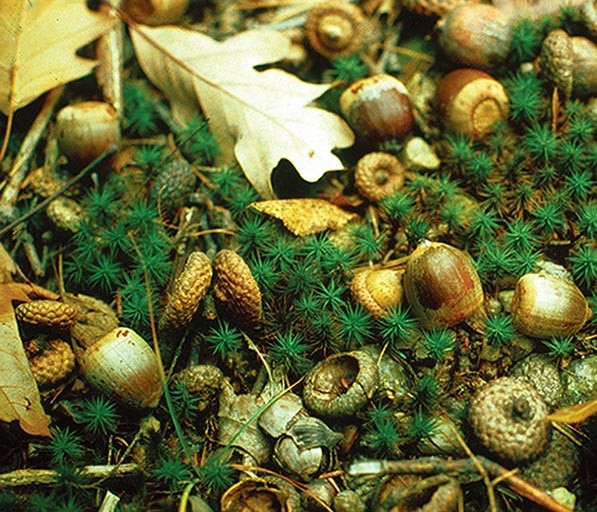Last fall when acorns were falling out of the oak trees by the thousands, a neighbor said we could expect a hard winter. Presumably the deer needed lots of acorns to last them through the winter. Well, the hard winter did indeed come, and I’m curious to know how the oak trees get the advance word and produce lots of acorns?
It seems that acorn production is one of those bits of folklore that was once used to predict the severity of the coming winter. In reality, though, it is a reflection of past weather (and other factors) rather than a predictor.
Research foresters have studied seed events extensively; one recent paper, for example, documented that from 2007 to 2011, six species of oak found growing on Long Island had between one and three good seed years, and that the one total bust year (2011) came on the heels of a significant drought. But while reports like these are long on numbers, they’re short on explanations. How do bumper crops come about, and why is it that so many trees in an area often produce bumper crops at the same time?
The synchronous, periodic production of large seed crops within tree populations is often called “masting.” How it happens can be explained by external environmental (mostly weather-related) and internal physiological (mostly energy-related) factors. Typically, each species responds to a particular set of weather conditions that triggers an expense of energy for seed production. Often, the weather at the time of bud formation (the previous growing season) is critical; it determines whether buds will develop into vegetative (leaves and shoots) or reproductive (flowers and fruits) structures. When conditions are just right (usually some temperature optimum), more reproductive buds are formed. Of course, weather conditions may continue to influence seed crop size by reducing the number of flowers and fruits that make it to viable maturity. Think late frosts, high winds, prolonged drought, or heavy rains.
It might be tempting to leave it there, concluding that it takes a lot of energy for a tree to produce flowers and fruits and that, well, gee, the more favorable the growing conditions (climate, moisture, light, nutrients), the greater the flower and seed crop. Turns out it isn’t that easy. Why groups of trees exhibit masting is far more complicated – and it might be connected to deer (and all the other critters that eat tree seeds).
Ecologists have speculated – and put forth supporting data – that masting is an adaptive reproductive strategy. The so-called “predator satiation” idea holds that trees starve would-be seed predators during lean years and overwhelm them with seed during bumper years. The lean years keep populations of seed-eating insects, mammals, and birds low enough that they cannot eat all the seeds during bumper years, so an excess is available for the regeneration of trees. Supporters of this theory point to long-term seed production records and note that in some tree species, seedling establishment is virtually confined to mast years. They also argue that the tendency for synchrony of seed production among trees in the same area is consistent with the theory. That is, genes of trees that produce seed out of synchrony with others would eventually be removed from the population by the voracious feeding of the otherwise starving seed predators.
The predator satiation theory has many supporters, and over the years they’ve tested it and refined it, adding new elements to the case. Some scientists, for example, have suggested that the interval between mast years may also be necessary for trees to recover their energy and mineral reserves from the last high-output year and to accumulate enough for the next one. More recently, pollination efficiency has been counted as another advantage of masting. The idea is that masting – especially when many surrounding trees are also doing it – increases the effectiveness of wind pollination. The more trees that flower at once, the better the chance for pollination, and the greater the proportion of filled, viable seeds that result. It’s an economy of scale, favoring large, occasional outputs of seed rather than frequent, small ones.
In its evolved form, the predator satiation theory provides a satisfying combination of the why and the how. If true, it would mean that trees have inherent cycles of seed production that have coevolved with seed-eating animals and that these built-in patterns are modified by the influence of weather conditions on tree physiology.



Discussion *